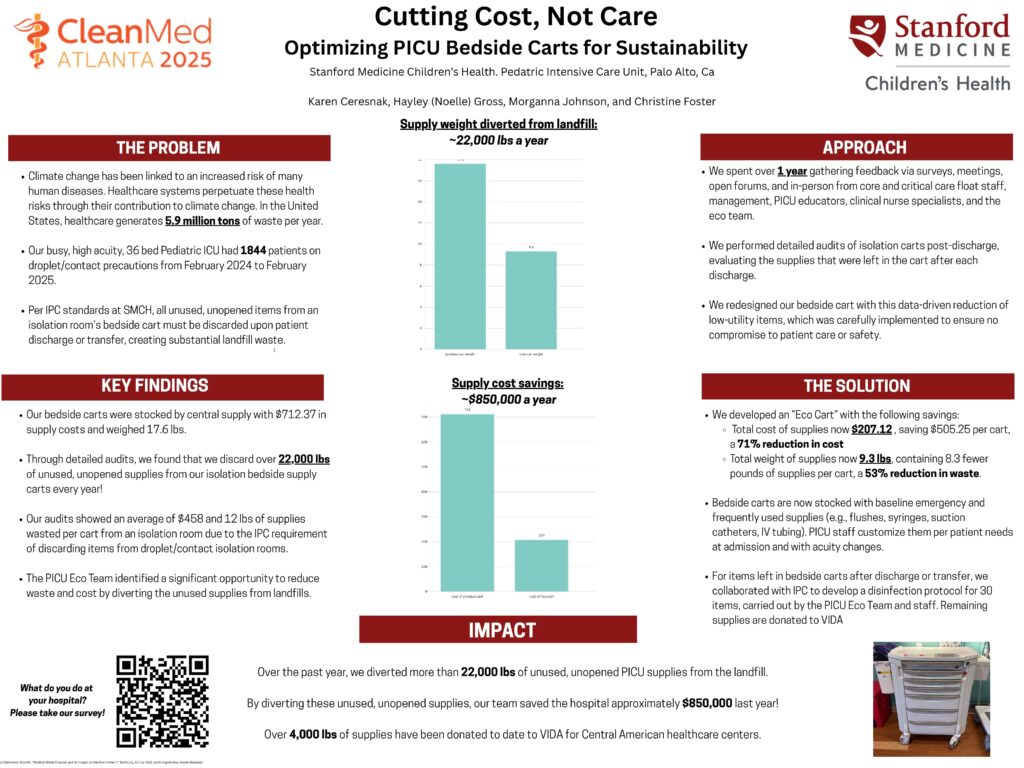Interviewee: Karen Ceresnak, Beside Nurse (BSN, RN)
Organization: Stanford Medicine Children’s Health
Initiative Overview
Karen Ceresnak and her colleagues in the Pediatric ICU formed an eco-sustainability team to identify and implement changes that would make their unit more environmentally sustainable. The team was nurse-driven, with ideas and projects originating from staff rather than being dictated by leadership.
The initiative began when a doctor in the unit, passionate about environmental sustainability, proposed creating a team inspired by a similar effort in another unit. Karen volunteered alongside two other nurses, Morgana Johnson and Noelle Gross, to lead the effort. The team met monthly and welcomed input from all staff members.
Project Implementation
The team’s first major undertaking addressed the staggering waste generated by bedside supply carts. Each cart, stocked with over $700 worth of supplies weighing 17 pounds, was routinely discarded in its entirety whenever a patient was discharged from isolation—even if the supplies remained unopened. This practice resulted in an alarming 22,000 pounds of unused medical supplies, valued at $1 million, being sent to landfills annually from their unit alone. To tackle this issue, the team pursued a multi-phase approach. First, they collaborated with Infection Prevention Control (IPC) to identify 30 items in the carts that could be safely disinfected and reused, such as saline flushes sealed in plastic. Nurses were trained to clean, dry, and return these items to the supply closet, diverting them from the waste stream. Next, the team conducted a thorough review of the cart contents, removing redundant or seldom-used items like arterial line setups and VAMP juniors. Through this process, they streamlined the carts to just $200 worth of essentials, reducing their weight to 8 pounds.
For supplies that couldn’t be disinfected, the team partnered with VIDA, an organization that redistributes medical supplies to underserved regions in Central America. This not only prevented waste but also extended the lifecycle of valuable resources. Currently, the team is exploring a third phase: researching whether contaminated supplies remain infectious over time. Given that viruses typically survive only hours on surfaces, this study could further reduce unnecessary waste by challenging long-held disposal protocols.

Collaborators
The success of the initiative relied on collaboration across multiple departments. Infection Prevention Control (IPC) played a critical role by approving disinfection protocols, while Environmental Services (EVS) adjusted their waste management procedures to align with the new system. The supply distribution team worked closely with the unit to ensure carts were restocked according to the revised inventory. Nurses, educators, managers, and physicians within the unit provided ongoing feedback and support, fostering a culture of collective responsibility. The hospital’s sustainability department offered both mentorship and funding, with its director serving as a key liaison to leadership. Finally, the partnership with VIDA ensured that unused supplies benefited communities in need.
Challenges and Solutions
Implementing the initiative was not without obstacles. Resistance to change emerged early on, as some nurses were hesitant to take on additional tasks. However, by clearly communicating the environmental and financial benefits—such as the $1 million going to landfills—the team gradually won over skeptics.
Navigating institutional bureaucracy proved equally daunting. At Stanford, even minor changes required layers of approval, and the team spent a year and a half in meetings before seeing tangible results. To overcome this, they leaned on the sustainability department director, who helped them connect with decision-makers and advocate for their cause.
Communication gaps also posed significant hurdles. Initially, Environmental Services (EVS) staff, unaware of the new protocol, continued discarding carts as before. Meanwhile, nurses needed frequent reminders to follow the updated process rather than relying on EVS. The supply distribution team, accustomed to stocking carts uniformly across the hospital, struggled to adapt to the unit’s unique needs. Addressing these issues required months of persistent education, emails, and hands-on training to ensure everyone understood their roles in the new system.

Results and Impact
The initiative’s outcomes were both measurable and transformative. By re-evaluating the contents of the bedside carts, the team slashed their cost from $700 to $200 and reduced their weight by more than half. The donation of unused supplies to VIDA not only diverted waste from landfills but also provided critical resources to healthcare providers in Central America.
Beyond the tangible benefits, the project sparked a cultural shift within the unit. Staff became more environmentally conscious, proposing additional ideas for sustainability, such as reducing single-use plastics and optimizing energy use. The initiative demonstrated that small, nurse-led actions could yield significant impacts, inspiring others to think creatively about sustainability in healthcare.
Advice for Nurses Starting Similar Initiatives
For nurses looking to launch their own sustainability projects, Karen offers several key lessons. First, assemble a small but dedicated team to share the workload and brainstorm ideas. Starting with a manageable pilot project can build momentum and demonstrate feasibility. Karen also emphasizes the importance of taking initiative early—she began her project before securing formal approval, reasoning that the worst-case scenario (supplies being discarded as usual) was no different from the status quo.
Persistence is critical, as institutional change often moves slowly. Identifying and engaging stakeholders early, from frontline staff to leadership, can help secure buy-in. Finally, while environmental benefits are compelling, highlighting cost savings can be a powerful motivator for gaining broader support.




